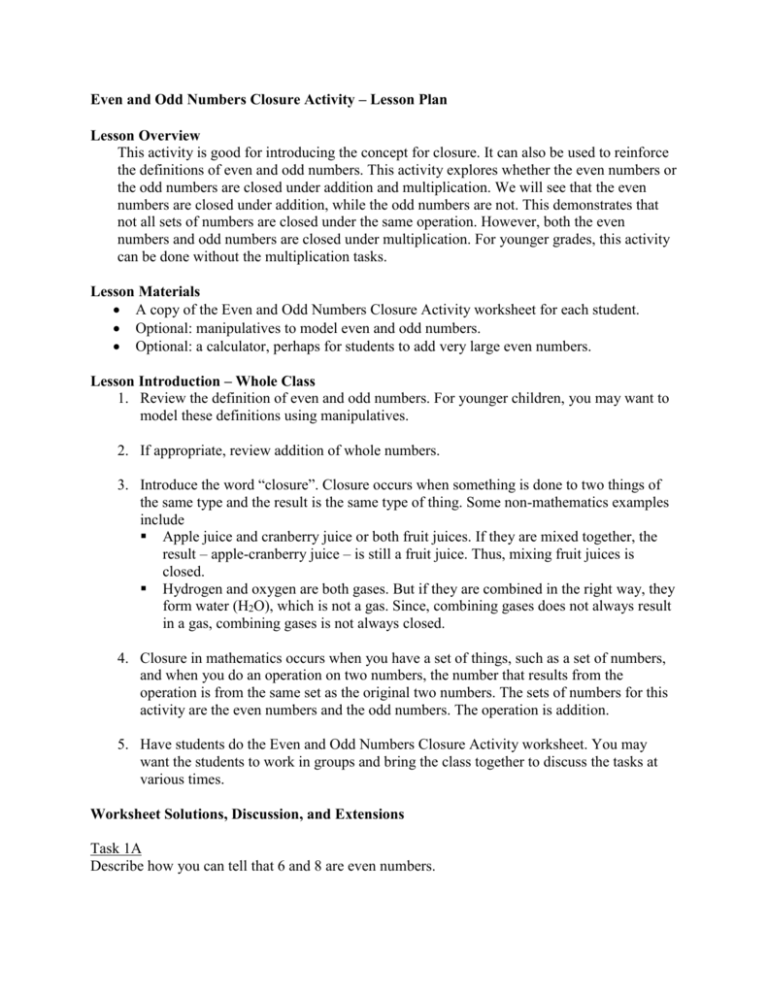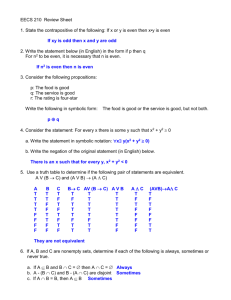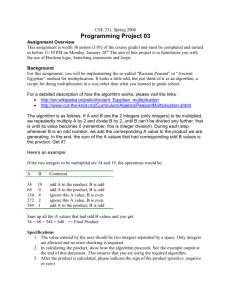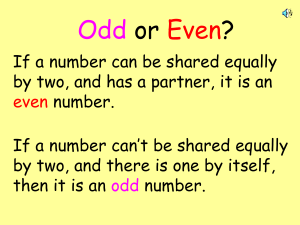Even and Odd Numbers Closure Activity – Lesson Plan
advertisement

Even and Odd Numbers Closure Activity – Lesson Plan Lesson Overview This activity is good for introducing the concept for closure. It can also be used to reinforce the definitions of even and odd numbers. This activity explores whether the even numbers or the odd numbers are closed under addition and multiplication. We will see that the even numbers are closed under addition, while the odd numbers are not. This demonstrates that not all sets of numbers are closed under the same operation. However, both the even numbers and odd numbers are closed under multiplication. For younger grades, this activity can be done without the multiplication tasks. Lesson Materials A copy of the Even and Odd Numbers Closure Activity worksheet for each student. Optional: manipulatives to model even and odd numbers. Optional: a calculator, perhaps for students to add very large even numbers. Lesson Introduction – Whole Class 1. Review the definition of even and odd numbers. For younger children, you may want to model these definitions using manipulatives. 2. If appropriate, review addition of whole numbers. 3. Introduce the word “closure”. Closure occurs when something is done to two things of the same type and the result is the same type of thing. Some non-mathematics examples include Apple juice and cranberry juice or both fruit juices. If they are mixed together, the result – apple-cranberry juice – is still a fruit juice. Thus, mixing fruit juices is closed. Hydrogen and oxygen are both gases. But if they are combined in the right way, they form water (H2O), which is not a gas. Since, combining gases does not always result in a gas, combining gases is not always closed. 4. Closure in mathematics occurs when you have a set of things, such as a set of numbers, and when you do an operation on two numbers, the number that results from the operation is from the same set as the original two numbers. The sets of numbers for this activity are the even numbers and the odd numbers. The operation is addition. 5. Have students do the Even and Odd Numbers Closure Activity worksheet. You may want the students to work in groups and bring the class together to discuss the tasks at various times. Worksheet Solutions, Discussion, and Extensions Task 1A Describe how you can tell that 6 and 8 are even numbers. The students should work with the definition or definitions given to them in class. Task 1B Add 6 and 8. Is their sum an even or odd number? How do you know? 6 + 8 is 14, which is an even number. Task 1C Pick two other even numbers and add them. Is their sum even or odd? How do you know? Answers will vary. Task 1D Can you find any two even numbers whose sum is not an even number? Why not? If students are modeling even numbers with manipulatives, they can show that the sum of two even numbers can always be modeled with a 2 x n rectangle since the addends are always 2 x n rectangles. Older students may be able to show that since the addends are divisible by 2,their sum must be divisible by 2. Task 1E Explain why the even numbers are closed under addition. By the definition of closure, since the sum of two even numbers is always an even number, then the even numbers are closed under addition. This is a good opportunity to discuss proof. A finite set of examples is not a proof in mathematics. Some other type of reasoning must be used to show something is true in all cases. The arguments given in Task 1D are proofs since they apply to any pair of even numbers. Task 2A Predict whether or not you think the odd numbers are closed under addition. This task is asking students to make a conjecture. You may want to introduce this word and explain that a conjecture is an educated guess, like a hypothesis in science. Task 2B Using the same process you used in Task 1, determine whether or not the odd numbers are closed under addition. Explain how you determined your answer. The odd numbers are not closed under addition. For example, 3 + 3 = 6. To prove something is not true in all cases, only one counterexample is needed. Thus, one counterexample is sufficient to prove something false, but an example – even many examples – are never sufficient to prove something true. This is an important concept to understand about reasoning and proof in mathematics. Task 3A Determine whether or not the even numbers are closed under multiplication. Explain how you determined your answer. The even numbers are closed under multiplication. The interpretation of multiplication as repeated addition can be used to prove this assertion. Since an even number plus an even number is always an even number, then repeatedly adding even numbers will result in an even number. Again, a few examples is not considered a proof. Task 3B Determine whether or not the odd numbers are closed under multiplication. Explain how you determined your answer. The odd numbers are closed under multiplication. The area model of multiplication can be used to prove this. All odd numbers are an even number plus 1. In the model below, one odd factor is represented by E+1, while the other odd factor is represented by e+1, where E and e are the two even numbers that are one less than odd factors. When E+1 is multiplied by e+1, the product is the sum of three even numbers (E x e + E + e) plus one. So, since the product is an even number plus one, the product must be an odd number. E 1 e E x e = even e 1 E 1 It is interesting to note that two different meanings of multiplication were used to prove the results in Task 3A and Task 3B. Task 4 Annie added 214 and 3368 and got 3583. Without adding, how can you use closure to tell that her answer is incorrect? Annie added two even numbers and the sum of two even numbers must be an even number since the even numbers are closed under addition, but 3583 is not an even number. This example shows that the knowing the closure properties of the numbers can be used in providing quick reasonableness checks to problem solutions.






